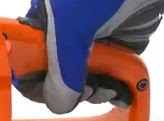The most important thing we share with our customers is safety education. Using machinery of any type can be dangerous and
power equipment is no exception. Being aware of proper safety practices can serve as a precaution as well as a boost of confidence to tackle a new project!
This series will be focused on
chainsaw safety. At the close of the series, we'll also offer open enrollment for a hands on chainsaw class. So if you're still not confident in your abilities, stay tuned for more details on that class.
As with any other job, the first step to a safe work environment is to
have the proper gear and be sure that it is in working order. Today we will discuss some of the protection options for doing tree work.
First and foremost, you always want to
protect your head. We offer several helmet styles, some of which include facial screens and ear protection. The important thing with a helmet is to be sure that it
fits snugly and won't fall off when you look up at the tree tops.
As mentioned before, you'll also want
ear and eye protection. Ear protection includes ear plugs, ear muffs, or noise cancelling head phones. Eye protection can range from a full facial screen to a simple pair of sun or safety glasses. We also offer goggles that seal to the face to prevent sawdust from getting in the eyes.
Next you'll want to be sure that all clothing is secure. No loose fitting clothing or saggy pants. Suspenders are available at Red Top Mower to provide extra security. You'll definitely want the suspenders if you decide to purchase our next safety item: chaps. Chaps are an additional protective layer that straps on around the waist and calves. Chaps are incredibly important because they protect your legs, which tend to be most often in the line of fire when it comes to chainsaw accidents.

You will be using your hands quite a bit and they'll be in close proximity to the bar and chain at all time, so it's crucial to have quality protective gloves designed with chain protection. This aspect of your gear won't prevent an injury but it will lessen the degree of the injury. Last but not least, you'll want to be sure to wear good sturdy footwear. Boots are best and should include steel toes, non-slip soles and if available, chain protection as well. It's always best to keep your feet away from falling limbs and rolling logs, but it's good to have the security of steel toed boots when a escaped log sneaks up on you!
Now you know, so get out and find some good quality protective gear. Stop by to see us and we'll outfit you with everything you need. We'll be back next week with the next installment: Know Your Saw.

















